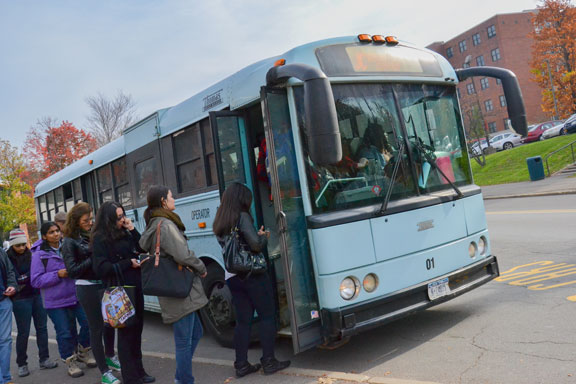
After two failed attempts and thousands of dollars, Off Campus College Transport is taking another stab at implementing ID scanners on its blue buses.
The OCCT’s third generation of ID scanners use radio-frequency identification (RFID) technology, allowing students to tap their ID cards rather than swipe them, as the second-generation scanners required.
Using scanners allows the Student Association to collect data such as the number of passengers and their status as either an undergraduate or graduate student, which Mark Soriano, the CEO of OCCT and SA president, said helps improve bus efficiency.
“The scanners provide data that can make the scheduled bus routes better represent commuting patterns, and will make the entire system more efficient for students and riders,” said Soriano, a senior majoring in history.
But the scanners are currently offline because of complications with the transition, according to Jesse Vogl, interim director of OCCT. Vogl said OCCT plan to finish with transition by the fall 2013 semester.
OCCT purchased 13 new RFID scanners, one for each bus, as well as one spare. Each RFID scanner cost about $300, totaling $3,900. The iPods used to collect ridership information are the same ones used by the second-generation swipe card readers, which cost about $1,600 total.
According to Eric Larson, CFO of OCCT and SA vice president for finance, the University paid for the original scanners, which cost $1,500 each, but the Student Association purchased the iPods, card readers and the new RFID scanners.
The first-generation scanners also used RFID technology, but Larson said technical issues forced OCCT to make the upgrade.
“The way the original RFID worked, it would read students’ cards and then the scanner’s software would dump the information into the central database,” Larson said. “But the scanners had issues where they would fail to dump the information.”
Henry Shapiro, a blue bus driver and senior majoring in economics, said that the second-generation swipe card readers were also inadequate because of the extra time students spent swiping ID cards.
“They were difficult to use, and they definitely made lines longer,” he said. “In the end, they caused bus routes to show up five minutes late, and eventually they just didn’t work.”
Soriano said he doesn’t expect the new scanners to have the same issues.
“I understand and agree with [student] concerns; the old scanners have caused lines and congestion,” Soriano wrote. “However, the new scanners should allow students to simply tap their card while they enter, and I cannot imagine any lines resulting.”
Mike Zagreda, a junior majoring in computer science, said he prefers the RFID system and hopes there are no issues with the new scanners.
“I’m happy they are bringing it back, but the system needs to really improve or else the students and the drivers are just going to forget about it, and that’s more of our money down the drain,” he said.
Ruth Lopez, a senior majoring in English, said she has rarely been asked to swipe her ID and that she prefers it that way.
“I honestly don’t remember having to scan that often at all,” she said, “which has been convenient because I haven’t had to wait on long lines much at all.”


